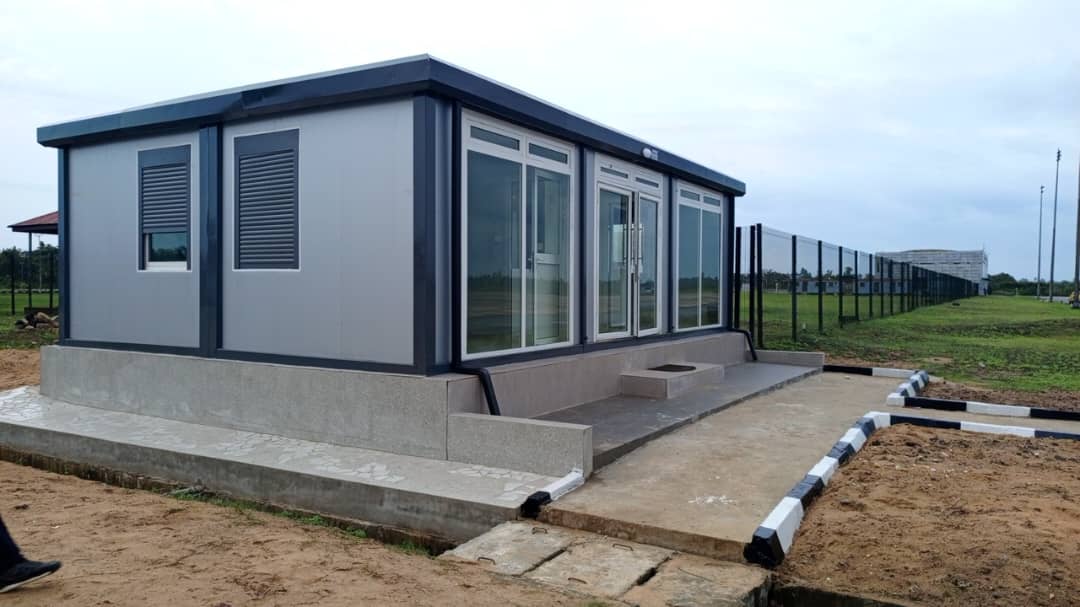
Introduction
Decision‑makers in government, real estate and housing finance face two constant pressures:
- Reduce project timelines
- Contain budgets.
Well, a prefab home offers a proven way to meet both goals. By shifting key build stages offsite, modular methods cut onsite work, lower waste and lock in quality under controlled conditions.
In Nigeria’s fast‑growing markets, prefab delivers reliable data‑driven savings. This guide shows you how prefab home solutions drive affordability, speed project delivery and meet local needs.
Let’s delve into the key advantages of Prefab Construction.
1. Prefab Home Time Advantage: Rapid Project Delivery
Key Point: Offsite assembly and parallel workflows shrink construction schedules by up to 50%.
-
Parallel Processes. While Karmod fabricates wall panels and roof modules, site crews prepare foundations. This overlap can cut total delivery time from 12 months to 6 months.
-
Weather‑Proof Workflow. Rain and high humidity often stall traditional builds. A factory setting stays dry and on schedule, preventing downtime.
-
Predictable Milestones. Factory output follows fixed daily targets. If Karmod plans 100 m² of wall panels per week, you track real progress against that goal.
These time gains free up capital sooner. Faster turnover reduces interest on construction loans. You move from ground‑break to hand‑over on a schedule you set.
2. Prefab Construction Cost: Breakdown of Savings
Key Point: Modular methods can lower your budget by 20–30% versus conventional builds.
| Cost Element | Traditional Build (₦/m²) | Prefab Solution (₦/m²) | Savings |
|---|---|---|---|
| Materials and waste | 200,000 | 170,000 | 15% |
| Labor | 80,000 | 60,000 | 25% |
| Overheads (site, logistics) | 40,000 | 25,000 | 38% |
| Total | 320,000 | 255,000 | 20% |
-
Lower Waste. Factory precision cuts scrap to under 5% of materials. Onsite waste runs near 15%.
-
Lean Labor. Skilled crews manage multiple projects concurrently at the factory. Onsite teams work fewer weeks, cutting labor costs.
-
Reduced Overheads. Controlled panel transport avoids multiple material deliveries. You save on haulage, site security and temporary services.
In total, a prefab home can save you over ₦65,000 per square meter in direct costs.
3. Modular Cost Savings: Data‑Driven Insights in Nigeria
Key Point: Nigeria’s housing deficit and rising material prices make cost control vital.
-
Housing Deficit. Nigeria needs 17 million units today. Annual demand exceeds 900,000 units. Prefab can close that gap faster.
-
Inflation Impact. Construction materials rose 25% in 2024 alone.² A controlled supply chain in prefab locks in steel and concrete panel costs for months ahead.
-
Bulk Production. Karmod orders raw steel and panels in volume. You share in lower per‑unit material rates.
¹ Federal Ministry of Works and Housing, 2024 report.
² Nigerian Bureau of Statistics, Building Materials Index, April 2025.
4. Durability and Quality: Suited for Local Climate
Key Point: Factory conditions and tested components ensure long‑term performance.
-
Engineered for Heat: insulated sandwich panels manage temperature swings. Tests in Lagos, Abuja and Port Harcourt showed interior variations within ±2 °C over six months.
-
Corrosion Resistance: galvanized steel frames come with a 25‑year anti‑rust warranty.
-
Wind‑Load Design: panels meet wind speeds up to 160 km/h—well above coastal storm levels.
UNE prefab home from Karmod stands up to sun, rain and shifting soils better than many onsite builds.
5. Affordable Prefab Housing: Financing Solutions
Key Point: Access multiple funding paths that favor prefab’s cost predictability.
-
National Housing Fund (NHF): employees and employers contribute to the NHF. Participants may borrow up to ₦2 million at single‑digit rates. Prefab projects qualify under “innovative construction.”
-
Mortgage Partnerships: federal Mortgage Bank of Nigeria supports prefab developers with priority approvals.
-
Green Bonds. International lenders back sustainable builds. A prefab home’s energy efficiency and reduced waste attract lower bond rates.
³ Federal Mortgage Bank of Nigeria
⁴ Central Bank of Nigeria PFI guidelines, 2025.
6. Regulatory Support: Government and Industry Links
Key Point: Official bodies recognize prefab as a strategic tool.
-
National Building Code. Appendix D covers modular panels and connections.
-
Customs Duty Exemptions. Prefab components imported under HS Code 9406 may receive duty relief for affordable housing.
-
Standards Organization of Nigeria (SON). SONCAP certifies Karmod panels for fire and structural safety.
Leverage these frameworks to streamline approvals and reduce upfront fees.
7. Case Studies: Nigerian Success Stories
Key Point: Real projects show real results.
7.1 Government Staff Housing, Ogun State
-
Project Size: 120 units
-
Timeline: 8 months (versus 18 months traditional)
-
Cost Savings: ₦500 million less than budgeted conventional cost
7.2 Affordable Community in Kano
-
Project Size: 200 homes
-
Financing: NHF mortgages + green bonds
-
Outcome: 30% cheaper than local brick‑and‑mortar peers
Each development proved that a prefab home meets quality and budget goals in urban and rural settings.
Conclusion
UNE prefab home delivers clear cost benefits, faster delivery and durable quality under Nigeria’s climate.
By reducing waste, securing material prices and streamlining labor, prefab construction cuts budgets by 20–30%. National rules and financing schemes favor modular projects.
For large‑scale government or private developments, prefab drives reliable schedules and lower risk.
To see how Karmod Nigeria can help you deliver affordable prefab housing on time and under budget, let’s discuss your next project. Reach out and explore solutions built for Nigeria’s needs.
To request for price quotation simply contact: +234(0)700-111-1112 or send an email tosales@karmod.com.ng
info@karmod.com.ng
